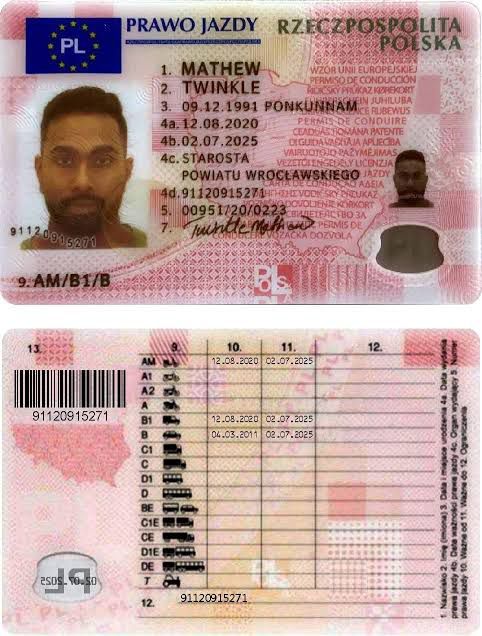What Is The Reason Driving Licenses B Is Right For You?
Understanding Driving Licenses: Types, Requirements, and Frequently Asked Questions
Driving is a basic aspect of contemporary life, and getting a driving license is a critical turning point for lots of people. This post checks out the numerous types of driving licenses offered, the requirements to acquire them, and answers commonly asked concerns connected to the topic. An educated perspective on driving licenses can assist people comprehend the value of choosing the appropriate type of license to meet their requirements.
Types of Driving Licenses
Driving licenses can differ between countries and regions, but they typically fall into several major categories. The following table sums up the most common kinds of driving licenses, including their functions and typical constraints.
Kind of License
Description
Typical Restrictions
Eligibility Age
Learner's Permit
Allows beginner drivers to practice.
Need to drive with a licensed adult.
16-18 years of ages
Class C License
Standard license for passenger cars.
No restriction on variety of passengers.
18 years or older
Class A License
Commercial license for large automobiles.
Should follow more stringent guidelines.
21 years or older
Class B License
For driving buses and bigger lorries.
May need unique recommendations.
21 years or older
Motorcycle License
For running bikes.
Must use a helmet; varies by state.
16-18 years of ages
International License
Enables legal driving in foreign countries.
Need to have a valid domestic license.
18 years or older
Student's Permit
The learner's authorization is the very first action for many individuals venturing into the world of driving. This license enables novice motorists to practice driving under monitored conditions, typically requiring a certified adult over a specific age to accompany them in the vehicle.
Class C License
The Class C license is the most frequently held driving license, enabling people to run standard guest automobiles. This license generally has actually fewer limitations compared to other categories.
Class A and B Licenses
Class A and B licenses are essential for operating business cars. norinegatski.top require unique training and testing, ensuring that drivers are geared up with the skills required for steering bigger and more intricate automobiles safely.
Motorcycle License
Individuals interested in riding bikes need to acquire a bike license, which can require additional training and testing. Safety gear, such as helmets, is often mandated by law.
International License
A worldwide driving license enables people to drive in foreign nations, but it is essential to have a valid domestic driving license in conjunction with the worldwide license.
Requirements to Obtain a Driving License
The requirements for acquiring a driving license can vary substantially by jurisdiction. However, there are common steps and requirements that many applicants will come across. Below is a list of basic requirements:
Age Requirement:
- Minimum age varies; student's permits are typically provided at 16, while complete licenses may need candidates to be 18 or older.
Vision Test:
- Most jurisdictions need applicants to pass a vision test to make sure safe driving abilities.
Written Test:
- New drivers should pass a written exam that covers traffic laws, road indications, and safe driving practices.
Driving Test:
- Practical driving tests are carried out to demonstrate an applicant's ability to operate a lorry safely under various conditions.
Costs:
- Payment of application and testing charges is usually required.
Proof of Identity:
- Applicants must offer valid recognition, such as a passport or birth certificate, in addition to evidence of residency.
Adult Consent (for minors):
- Parental or guardian authorization is frequently required for applicants under the age of 18.
Understanding the different types of driving licenses and their involved requirements is essential for anyone wanting to drive lawfully and safely. Each license serves a distinct purpose, dealing with numerous driving requirements, from standard lorries to industrial transport and motorcycles. By fulfilling the needed requirements and adhering to regulations, aspiring chauffeurs can delight in the flexibility of driving while guaranteeing their security and the security of others.
Often Asked Questions (FAQs)
What do I require to bring when getting a driving license?
- You generally need to provide recognition, evidence of residency, and any essential application fees. Consult your regional DMV or licensing authority for particular requirements.
How long does it take to obtain a driving license?
- The timeline can vary based upon specific scenarios, such as how quickly one can complete the required tests, and whether there is a backlog at the licensing authority.
Can I drive with a student's license?
- Yes, however you must be accompanied by a certified driver and adhere to constraints set by your local laws.
What happens if I fail the driving test?
- You normally have the choice to retake the test after a designated waiting period, which differs by jurisdiction.
Is it required to take a driving course?
- While not always mandatory, taking a motorist's education course can be helpful and is frequently required for individuals seeking a learner's permit.
By being notified about the kinds of licenses offered, the requirements necessary for getting one, and the related regulations, prospective drivers can browse the process of acquiring a driving license with confidence.
